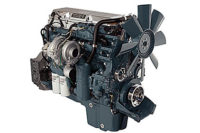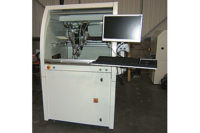Dager Systems, a division of Kimastle Corp., is a full-service manufacturer and integrator of secondary machinery for assembly applications. The company has helped many customers in the defense, aerospace and motorized vehicle industries, with a primary focus on engineering, research and development, and robotic integration.
However, Dager Systems faced a major manufacturing challenge of its own in 2012. The company needed to update the control architecture of its new edge-folding machines, which create the folded edge of sunroofs. Specifically, Dager wanted to eliminate the use of either a network communications adaptor or hardwired parallel cables running back to the PLC I/O—without increasing the machines’ operational costs.
As part of their research of the controls market, Dager management met with Balluff, a long-term supplier of sensors and identification systems. Balluff recommended Dager use a Distributed Modular I/O block with each edge-folding machine. This would reduce labor costs for building the machine, while increasing machine flexibility and expandability.
“The modularity and expandability are top priorities,” says Moe VanPeteghem, controls manager for Dager Systems. “We have multiple tools that can be changed out, and must meet future expansion requirements without adding cost to the machines.”
The core of the Distributed Modular I/O block is an IO-Link hub, which features simple, fast and cost-effective point-to-point technology. The hub enables Dager to network pneumatic manifolds and expand the functionality of a single Ether-net/IP node without incurring the cost or dealing with the complexity of adding network nodes.
VanPeteghem says the Distributed Modular I/O block lowers the cost of networking pneumatic valve manifolds. Dager saves an average of $350 in hardware per manifold, and $1,400 per machine, by eliminating the DeviceNet node adapters. VanPeteghem says the technology enables the company to now use six Ethernet/IP nodes rather than 14 DeviceNet nodes.
“The IO-Link technology is seamless,” says VanPeteghem. “We didn’t even have to change our pneumatic manifold valves. We just kept the same manifold and used the IO-Link 25-D connectors tied back to the Ethernet/IP node. The IO-Link also eliminates about 3 hours of labor to hardwire the valve banks, resulting in a labor savings of $150 to $200 per bank.”
The block also reduces enclosure space by moving more I/O out of the cabinet and onto the machine. IO-Link hubs are positioned close to the sensors to reduce cable runs and allow operators to see the status LED and the sensors simultane-ously.
“Ease of maintenance is a prime concern of our customers,” says Rob Houston, vice president of sales and operations for Dager Systems. “Should anything happen to one of the sensors, this machine-mount I/O allows maintenance people to quickly identify the issues and get production going much faster.”
IO-Link hubs also include identification data fields, which enable Dager to track interchangeable tools to ensure proper machine setup. Because multiple tools can be used with each machine, it is essential to know that the correct tool is loaded for the intended job.
“This setup aide ensures we minimize changeover time, which is critical for our customers to maintain their production schedules.”
For more information on I/O hubs and identification systems, call 800-543-8390 or visit www.balluff.us.
Latest Pneumatic Controls Increase Assembly Capabilities

Dager Systems’ new generation of edge-folding machines are used to manufacture sunroofs. Photo courtesy Balluff Inc.

Distributed Modular I/O blocks feature an IO-Link hub, which enables Dager Systems to more cost-effectively network pneumatic manifolds. Photo courtesy Balluff Inc.

